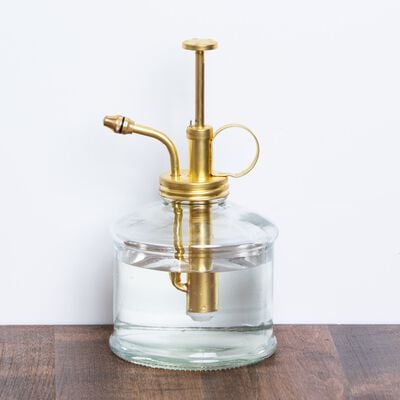Fiddle leaf fig, known in formal circles as Ficus lyrata, has been the Instagram “it” houseplant for years—and for good reason: Its tall, sleek trunk and broad, deeply veined, upward-facing, fiddle-shaped leaves make it feel more like a work of art than a plant—except a framed Picasso won’t ever reach your ceiling.
How To Keep a Fiddle Leaf Fig Plant Happy
Native to the lowland rainforests of Western Africa, fiddle leaf figs like humidity. Just give them water, plenty of sunshine, and an occasional misting, and these fast growers will repay you with instant gratification.
How Much Light Does a Fiddle Leaf Fig Plant Need?
Fiddle leaf figs need a lot of bright sunlight—but it’s best to filter that light by placing a sheer curtain over your window to protect the plant from sunburn.
Rotate your plant’s pot a quarter turn once a week to ensure all plant parts get even exposure.
How Do I Know When To Water My Fiddle Leaf Fig Plant?
Fiddle leaf figs need a drink of room temperature water every week or two, depending on the amount of light and humidity in your home. This can change with the seasons, so let your finger be your guide--stick it two inches into the soil and feel around for moisture. If it’s dry down there, apply water slowly until it drains out the bottom of the pot. When the draining stops, empty the saucer.
Fiddle leaf figs can better handle under watering than overwatering, so if you’re not sure if your plant is thirsty, hold off a bit.
How Do I Use Plant Food For My Fiddle Leaf Fig Plant?
Feed your fiddle leaf fig plant every time you water during spring and summer. Use indoor plant food and follow the dosing instructions on the label.
What Is The Ideal Environment For My Fiddle Leaf Fig Plant?
Fiddle leaf fig plants can get by with ordinary indoor humidity but prefer a light misting every few days. If you really want to be a hero, install a humidifier nearby.
Don’t let the room get cooler than 50 degrees, keep the temperature consistent, and keep your plant away from cold drafts and heating sources.
How Do I Prune and Maintain My Fiddle Leaf Fig Plant?
The best time to prune your fiddle leaf fig is during spring or summer, and the best tool for the job is a pair of clean, sharp pruning shears.
If the plant gets too tall for your space--or if side branches grow too long--prune them down to size by cutting just above a leaf.
If you’re happy with your plant’s height and don’t want it to grow taller, pinch off new leaves as they sprout from the top of the trunk (use your fingers).
If one of the plant’s branches crisscrosses another, prune the wonky one off about an inch away from the plant’s main trunk.
And feel free to trim off any brown or damaged leaves as you see them.
Just like your vinyl collection, houseplant foliage can gather dust—and that could lead to health issues. So when you’re dusting your furniture, wipe the tops and bottoms of leaves with a water-moistened cloth. That will unclog your plant’s pores and help it breathe freely.
How To Address Common Fiddle Leaf Fig Plant Issues
Droppy leaves can be a sign of too much water, too little water, cold drafts, or heat blasts. Inspect your plant’s location—and your watering practices—and adjust accordingly.
Brown leaves--or brown spots on leaves—often point to root rot, which can be deadly, so act quickly. Check that you haven’t been overwatering, inspect the pot’s drainage hole for blockages, and make sure the plant isn’t sitting in a saucer of water.
Next, you’ll need to inspect the roots: Protect your floor with a newspaper or tarp—depending on how large the plant is—and gently slip your fiddle leaf fig out of its pot. Are the roots white and fresh-looking? You’re golden! Make sure the plant is far from cold drafts, radiators, and heating vents, and move it into a sunnier spot.
Are the roots yellow, brown, or mushy? Sounds like root rot—a fungal disease that takes root when plants are overwatered. Using your sharp, clean pruners, cut away the sick-looking parts, wash the container with water and bleach, rinse well, and repot the plant using fresh potting mix.
Disinfect your pruners and then use them to clip away any affected leaves.
Yellow leaves are usually a sign of your fiddle leaf fig has a bacterial infection. Clip them away, remove the plant from its pot, disinfect the container with water and bleach, and replant it in fresh potting mix.
What To Do If You Still Have Questions
If your fiddle leaf fig plant doesn’t seem to feel at home in your space, we’re here to help! You can chat with a live Greendigs specialist 24/7 by clicking here. You can also shoot us an email at [email protected].
More Tips From Our Team of Growers
Even green thumbs need a helping hand.

Satisfy a growing appetite by giving your plants a boost of nourishment.

We water, feed, dust, and even house our leafy friends in stylish pots—but what do our plants do for us?

A little dusting can go a long way.

Some plants like their home to feel a little more tropical—and who can blame them?
